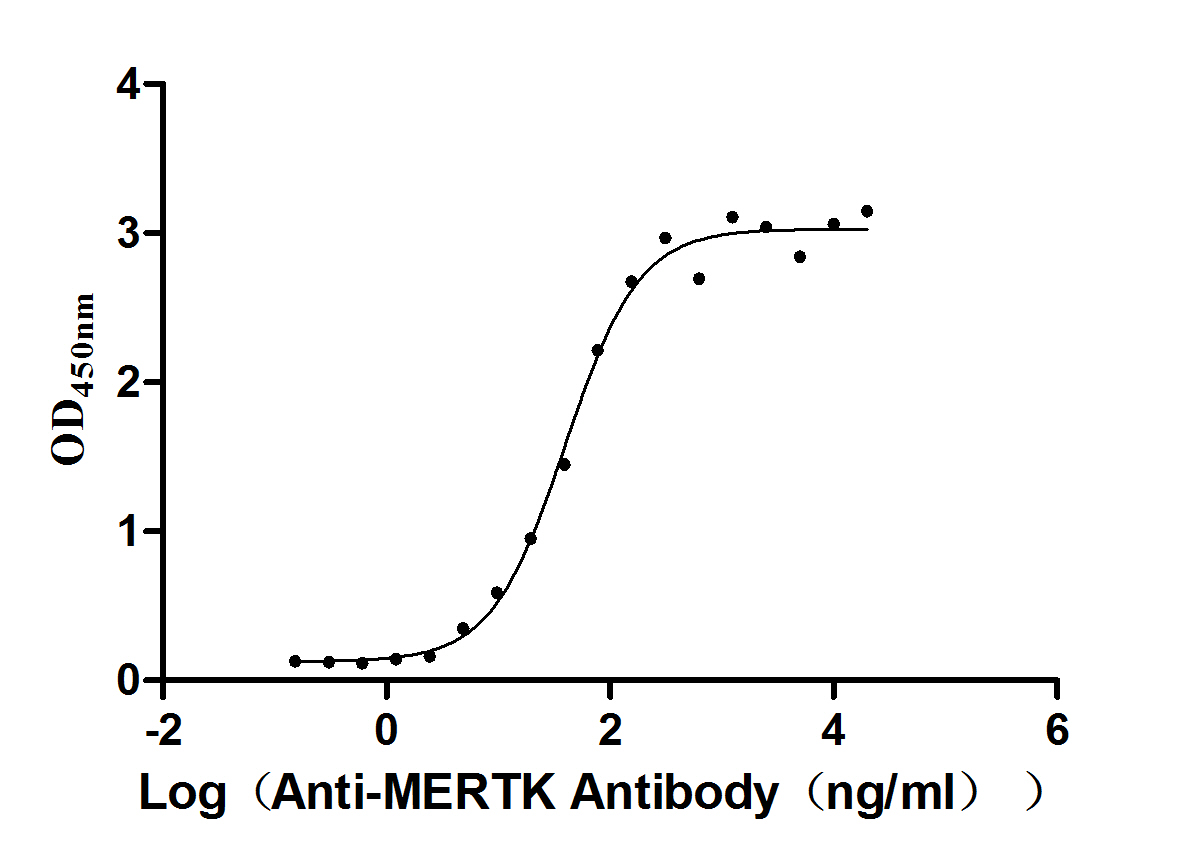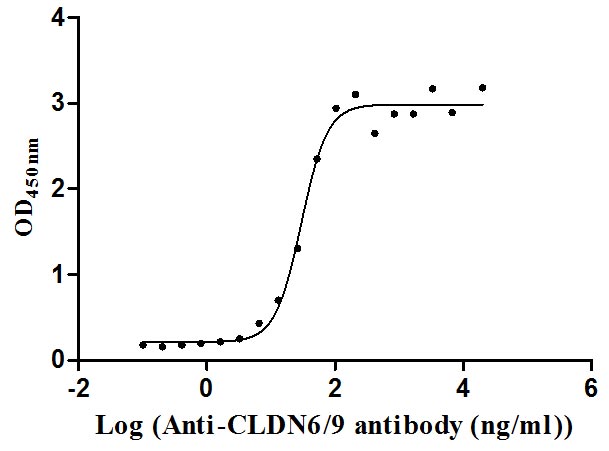Recombinant Mouse Glycine N-methyltransferase (Gnmt)
-
中文名稱:小鼠Gnmt重組蛋白
-
貨號:CSB-YP009628MO
-
規(guī)格:
-
來源:Yeast
-
其他:
-
中文名稱:小鼠Gnmt重組蛋白
-
貨號:CSB-EP009628MO
-
規(guī)格:
-
來源:E.coli
-
其他:
-
中文名稱:小鼠Gnmt重組蛋白
-
貨號:CSB-EP009628MO-B
-
規(guī)格:
-
來源:E.coli
-
共軛:Avi-tag Biotinylated
E. coli biotin ligase (BirA) is highly specific in covalently attaching biotin to the 15 amino acid AviTag peptide. This recombinant protein was biotinylated in vivo by AviTag-BirA technology, which method is BriA catalyzes amide linkage between the biotin and the specific lysine of the AviTag.
-
其他:
-
中文名稱:小鼠Gnmt重組蛋白
-
貨號:CSB-BP009628MO
-
規(guī)格:
-
來源:Baculovirus
-
其他:
-
中文名稱:小鼠Gnmt重組蛋白
-
貨號:CSB-MP009628MO
-
規(guī)格:
-
來源:Mammalian cell
-
其他:
產(chǎn)品詳情
-
純度:>85% (SDS-PAGE)
-
基因名:Gnmt
-
Uniprot No.:
-
別名:GnmtGlycine N-methyltransferase; EC 2.1.1.20
-
種屬:Mus musculus (Mouse)
-
蛋白長度:Full Length of Mature Protein
-
表達區(qū)域:2-293
-
氨基酸序列VDSVYRTRS LGVAAEGLPD QYADGEAARV WQLYIGDTRS RTAEYKAWLL GLLRQHGCHR VLDVACGTGV DSIMLVEEGF SVMSVDASDK MLKYALKERW NRRKEPSFDN WVIEEANWLT LDKDVLSGDG FDAVICLGNS FAHLPDCKGD QSEHRLALKN IASMVRPGGL LVIDHRNYDY ILSTGCAPPG KNIYYKSDLT KDITTSVLTV NNKAHMVTLD YTVQVPGTGR DGSPGFSKFR LSYYPHCLAS FTELVRAAFG GRCQHSVLGD FKPYKPGQAY VPCYFIHVLK KTD
-
蛋白標(biāo)簽:Tag?type?will?be?determined?during?the?manufacturing?process.
The tag type will be determined during production process. If you have specified tag type, please tell us and we will develop the specified tag preferentially. -
產(chǎn)品提供形式:Lyophilized powder
Note: We will preferentially ship the format that we have in stock, however, if you have any special requirement for the format, please remark your requirement when placing the order, we will prepare according to your demand. -
復(fù)溶:We recommend that this vial be briefly centrifuged prior to opening to bring the contents to the bottom. Please reconstitute protein in deionized sterile water to a concentration of 0.1-1.0 mg/mL.We recommend to add 5-50% of glycerol (final concentration) and aliquot for long-term storage at -20℃/-80℃. Our default final concentration of glycerol is 50%. Customers could use it as reference.
-
儲存條件:Store at -20°C/-80°C upon receipt, aliquoting is necessary for mutiple use. Avoid repeated freeze-thaw cycles.
-
保質(zhì)期:The shelf life is related to many factors, storage state, buffer ingredients, storage temperature and the stability of the protein itself.
Generally, the shelf life of liquid form is 6 months at -20°C/-80°C. The shelf life of lyophilized form is 12 months at -20°C/-80°C. -
貨期:Delivery time may differ from different purchasing way or location, please kindly consult your local distributors for specific delivery time.Note: All of our proteins are default shipped with normal blue ice packs, if you request to ship with dry ice, please communicate with us in advance and extra fees will be charged.
-
注意事項:Repeated freezing and thawing is not recommended. Store working aliquots at 4°C for up to one week.
-
Datasheet :Please contact us to get it.
靶點詳情
-
功能:Catalyzes the methylation of glycine by using S-adenosylmethionine (AdoMet) to form N-methylglycine (sarcosine) with the concomitant production of S-adenosylhomocysteine (AdoHcy). Possible crucial role in the regulation of tissue concentration of AdoMet and of metabolism of methionine.
-
基因功能參考文獻:
- Hepatic GNMT regulates lipid and glucose homeostasis, and provide insight into the development of insulin resistance through modulating the PI3K/Akt pathway. PMID: 27716281
- GNMT is involved in the pathogenesis of experimental autoimmune encephalomyelitis and plays a crucial role in the regulation of CD4+ T-cell functions PMID: 25535034
- GNMT is found in the hippocampus and regulates intracellular SAMe levels. GNMT deficiency in mice results in high SAMe levels within the hippocampus, reduced neurogenic capacity, and spatial learning and memory impairment. PMID: 24687756
- It may be a crucial molecule in the pathogenesis of DSS-induced colitis. PMID: 24219143
- Gnmt plays important role in maintaining normal function of brain; deficiency of Gnmt causes dysfunction of important signaling pathways and results in alterations of neurotransmitter secretion as well as changes in neuropsychological behavior. PMID: 22264868
- Reduced expression of GNMT in mouse hepatoma cells appears to increase the activity of LKB1/RAS signaling. PMID: 22687285
- NK cells from GNMT(-/-) mice were spontaneously activated, expressed more TRAIL, and had strong cytotoxic activity, suggesting their contribution to the proinflammatory environment in the liver. PMID: 22392635
- This is the first report demonstrating that GNMT plays an important role in regulating cholesterol homeostasis via interaction with NPC2 PMID: 22183894
- Higher susceptibility to aflatoxin B(1)-related hepatoma in Gnmt deficient mice. PMID: 20473876
- Loss of GNMT induces aberrant methylation of DNA and histones, resulting in epigenetic modulation of critical carcinogenic pathways. PMID: 18318442
- GNMT is a tumor suppressor gene for liver cancer, and it is associated with gender disparity in liver cancer susceptibility as shown in humans and in mouse models PMID: 19035462
- critical role during liver regeneration, promoting hepatocyte viability and normal proliferation PMID: 19582817
顯示更多
收起更多
-
亞細胞定位:Cytoplasm.
-
蛋白家族:Class I-like SAM-binding methyltransferase superfamily, Glycine N-methyltransferase family
-
數(shù)據(jù)庫鏈接:
Most popular with customers
-
Recombinant Human Tyrosine-protein kinase Mer (MERTK), partial (Active)
Express system: Mammalian cell
Species: Homo sapiens (Human)
-
Recombinant Human Claudin-18.2 (CLDN18.2)-VLPs (Active)
Express system: Mammalian cell
Species: Homo sapiens (Human)
-
Recombinant Mouse Retinol-binding protein 4 (Rbp4) (Active)
Express system: Mammalian cell
Species: Mus musculus (Mouse)
-
Recombinant Human Claudin-9 (CLDN9)-VLPs (Active)
Express system: Mammalian cell
Species: Homo sapiens (Human)
-
Recombinant Human Transferrin receptor protein 1 (TFRC), partial (Active)
Express system: Mammalian cell
Species: Homo sapiens (Human)
-
Recombinant Human C-C chemokine receptor type 5 (CCR5)-VLPs (Active)
Express system: Mammalian cell
Species: Homo sapiens (Human)



-AC1.jpg)













